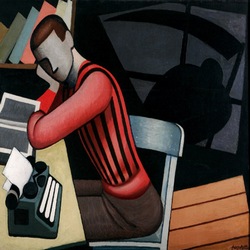Twenty years after his death Cuban intellectual Marcelo Pogolotti
- Submitted by: admin
- Arts and Culture
- Caribbean
- Destinations
- history
- Literature
- national
- Paint and Sculpture
- personalities
- 08 / 28 / 2008

Pogolotti’s father was Italian and his mother was English. However, neither his early contacts with Italian futurists and the European artistic scene prior to World War II, nor his long stays abroad, distracted him from cultivating his Cuban identity, emotionally as well as rationally. In 1931, Alejo Carpentier said of him in the magazine ‘Social’: “The painter of the most advanced techniques and ideas in Cuba thus far.”
Artistically speaking, Pogolotti’s Cuban identity first expressed itself when he participated in the Havana Art Exhibit (Art Nouveau) in 1927. He soon became internationally famous for his fresh impetus, in close contact with Parisian avant-garde artists of the period between the wars. But, while for some rupture and innovation had to do only with the form, not the content, in Pogolotti that anxiety evolved into a radical thinking.
His daughter, renowned Cuban essayist and profesor Graziella Pogolotti, explained that her father: "Felt that art could not be alien to the problems affecting society and contemporary history. In that sense, abstraction led to a dead end. New ways were to be found to express and reflect the main conflicts of his time: the big conflicts of the modern age and history in a period that was extremely complex.”
It was by then that Pogolotti painted his famous ‘Paisaje cubano’ (1933), in which he, from an advanced aesthetic perspective, reflected the real motive behind the social conflict in his homeland - the neo-colonial regime.
Who knows how much more Pogolotti would have advanced in his painting had he not become blind by the late 1930s at the height of his career. What new and surprising works he could have left us, an artist who managed to reflect on canvas the inhumane character of the prevailing system and strongly denouncing it (see Pogolotti’s paintings ‘El capitalismo’(image), ‘Dockers’ and ‘El intelectual’).
Pogolotti followed that same path in his literary creation. His novel ‘Estrella Molina’(1946) set a precedent in terms of the narrative technique. Writer Alberto Agrandes said: “his scrupulous, some times zigzagging and almost always reflection-inviting prose” of those “well-structured texts -- using some film techniques -- demanded from the reader some collaboration to figure out the ‘hinges’ or links that gave continuity to the plot.”
The avant-garde, innovative character of Pogolotti’s paintings and literary works should be seen as a source of both curiosity and concern, guiding us as we go along the new paths of creativity.
(www.granma.co.cu)
Comments